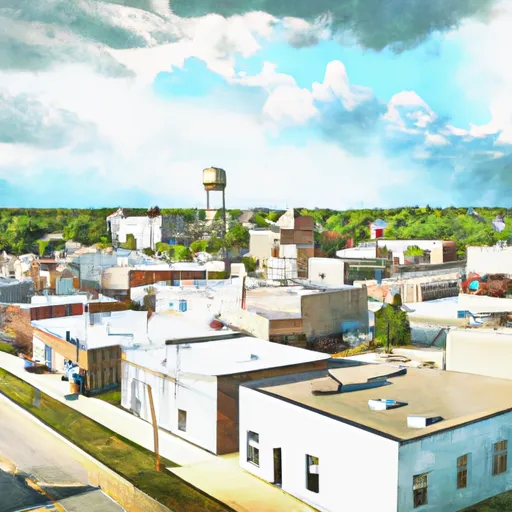-
 Snoflo Premium
Snoflo Premium
Get unlimited access to all our content
With no Ad interruptions! - Start Your Free Trial Login with existing account
Rosalia
Eden Index
Climate
8.3
•
Recreation
0.6
•
Community
2.4
•
Safeguard
4.1/10

Rosalia, Kansas is a charming small town located in Butler County. The climate in Rosalia can be described as a humid subtropical climate with hot summers and mild winters. Summers are typically hot and can experience occasional thunderstorms, while winters are generally mild with occasional snowfall. The region enjoys a moderate amount of rainfall throughout the year, making it suitable for agriculture.
The hydrology constituents in Rosalia are primarily influenced by the Walnut River, which flows near the town. The river provides opportunities for fishing and boating, with various species of fish like catfish, bass, and crappie that can be found in its waters. Additionally, Rosalia is home to several small ponds and lakes, offering additional recreational opportunities for fishing and relaxation.
Outdoor enthusiasts will find a variety of activities to enjoy in Rosalia. The area is surrounded by beautiful natural landscapes, making it ideal for hiking, camping, and bird-watching. The Walnut River also attracts canoeing and kayaking enthusiasts, providing a scenic and tranquil experience on the water.
Overall, Rosalia, Kansas offers a pleasant climate, diverse hydrology constituents, and various outdoor recreation opportunities, making it an attractive destination for nature lovers and outdoor enthusiasts.
What is the Eden Index?
The Snoflo Eden Index serves as a comprehensive rating system for regions, evaluating their desirability through a holistic assessment of climate health, outdoor recreation opportunities, and natural disaster risk, acknowledging the profound impact of these factors on livability and well-being.
Climate Health Indicator (CHI): 8.3
Rosalia receives approximately
921mm of rain per year,
with humidity levels near 80%
and air temperatures averaging around
13°C.
Rosalia has a plant hardyness factor of
6, meaning
plants and agriculture in this region thrive during a short period during spring and early summer. Most
plants will die off during the colder winter months.
By considering the ideal temperature range, reliable water supplies, clean air, and stable seasonal rain or snowpacks, the Climate Health Indicator (CHI) underscores the significance of a healthy climate as the foundation for quality living.
A healthy climate is paramount for ensuring a high quality of life and livability in a region, fostering both physical well-being and environmental harmony. This can be characterized by ideal temperatures, reliable access to water supplies, clean air, and consistent seasonal rain or snowpacks.
Weather Forecast
Streamflow Conditions
Middle Arkansas
Area Rivers
Middle Arkansas
Snowpack Depths
Middle Arkansas
Reservoir Storage Capacity
Middle Arkansas
Groundwater Levels
Recreational Opportunity Index (ROI): 0.6
The Recreational Opportunity Index (ROI) recognizes the value of outdoor recreational options, such as parks, hiking trails, camping sites, and fishing spots, while acknowledging that climate plays a pivotal role in ensuring the comfort and consistency of these experiences.
Access to outdoor recreational opportunities, encompassing activities such as parks, hiking, camping, and fishing, is crucial for overall well-being, and the climate plays a pivotal role in enabling and enhancing these experiences, ensuring that individuals can engage in nature-based activities comfortably and consistently.
Camping Areas
| Campground | Campsites | Reservations | Toilets | Showers | Elevation |
|---|---|---|---|---|---|
| Feyodi Creek RV Park | 54 | 755 ft | |||
| Tuttle Creek State Park | 700 | 1,027 ft | |||
| Tuttle Creek Cove - Tuttle Creek Lake | 55 | 1,183 ft | |||
| Stockdale - Tuttle Creek Reservoir | None | 1,157 ft | |||
| Jim Thorpe Park | None | 912 ft | |||
| El Dorado State Park | 1100 | 1,360 ft | |||
| Bluestem Lake | None | 915 ft | |||
| Blue Rapids/Riverside City Park | None | 1,121 ft | |||
| Oregon Trail RV Park | 16 | 1,182 ft | |||
| Hominy Municipal Lake | None | 895 ft |
Catastrophe Safeguard Index (CSI):
The Catastrophe Safeguard Index (CSI) recognizes that natural disaster risk, encompassing floods, fires, hurricanes, and tornadoes, can drastically affect safety and the overall appeal of an area.
The level of natural disaster risk in a region significantly affects safety and the overall livability, with climate change amplifying these risks by potentially increasing the frequency and intensity of events like floods, fires, hurricanes, and tornadoes, thereby posing substantial challenges to community resilience and well-being.
Community Resilience Indicator (CRI): 2.4
The Community Resilience Indicator (CRI) recognizes that education, healthcare, and socioeconomics are crucial to the well-being of a region. The CRI acknowledges the profound impact of these elements on residents' overall quality of life. By evaluating educational resources, healthcare accessibility, and economic inclusivity, the index captures the essential aspects that contribute to a thriving community, fostering resident satisfaction, equity, and social cohesion.

